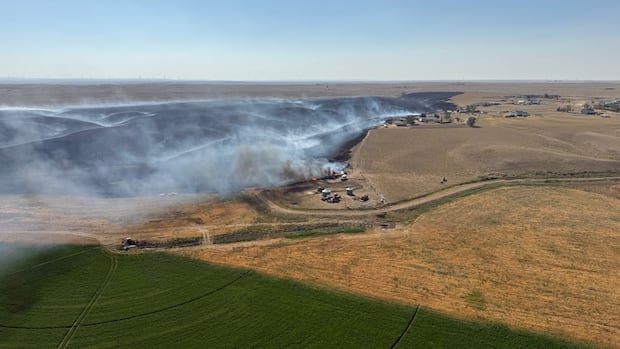Roughly 500 years ago in California's High Sierra, pine cones dropped to the ground and a cycle began. The Aztec Empire was falling. The printing press was new. The seedlings grew.
Half a millennia later, U.S. Forest Service scientists began testing strategies to save these now ancient and massive trees in the little-known area east of Fresno called the Teakettle Experimental Forest. They had plans to light a huge prescribed burn to clear overgrowth next year.
Advertisement Advertisement
Advertisement Advertisement
But then the Garnet Fire ignited amid a lightning storm and scorched all 3,000 federally protected acres on its path through the Sierra National Forest.
"There are large swaths where everything is dead - all the trees are dead," said Scott Scherbinski, a biologist and program manager at the Climate & Wildfire Institute. "It will be a start-over event for this forest."
Old growth forests across the American West are at risk of disappearing within the next 50 years due to a combination of extensive drought-related tree deaths and high severity fire, according to recent studies.
Malcolm North, a Forest Service ecologist and lead researcher on the Teakettle for 30 years, said the forest is a tragic example of that risk.
Advertisement Advertisement
Advertisement Advertisement
Fires with less intensity can be beneficial in California's fire-adapted landscapes, but the Garnet Fire, when it burned through in September, may have killed most trees and sterilized the ground - making it unlikely the forest can rebound without significant intervention.
It's not just big trees that were lost, but also the chance to continue research under way for decades. Over the years, researchers marked and tracked about 40,000 trees and tested various fire and thinning methods and generated pioneering research into forest health.
Scott Stephens, a professor of fire science at UC Berkeley, said the Teakettle held enormous scientific value because of the sheer amount of data collected over the past 30 years.
"That being lost is a tragedy to science," Stephens said. "You can't recreate that."
Advertisement Advertisement
Advertisement Advertisement
In 1938, the U.S. Forest Service set aside 3,000 acres about 80 miles east of Fresno to study hydrology and named it Teakettle after a creek. They originally set out to study whether tree thinning sent more water flowing into the creek for Central Valley farmers, but that research was scrapped after similar studies elsewhere found no benefit.
The Teakettle Experimental Forest within the Sierra National Forest is 80 miles east of Fresno, pictured in 2017. (U.S. Forest Service)
The Teakettle is one of 76 experimental forests established by the federal government for ecological research. Before the fire, it was open to the public but had no established trails. Only a small sign on a locked gate marked its borders and it was primarily visited by researchers and hunters.
About 30 years ago, North and other scientists launched a series of studies on the Teakettle into forest thinning and prescribed burning to restore a healthier balance to what had become overgrown forests. Towering sugar pine and Jeffrey pine had grown to hulking proportions with 9-foot diameter trunks, but these large trees were being choked by small trees and underbrush.
Advertisement Advertisement
Advertisement Advertisement
Teams found evidence that fires had occurred naturally about every 12 to 15 years in the Teakettle until the federal government stopped letting wildfires burn in the late 1800s. Before the Garnet Fire, the last major wildfire in the Teakettle had burned in 1865, and since then smaller trees, shrubs and debris had proliferated and created "a dangerous situation," North said.
Led by North, researchers tried six methods for clearing overgrowth on 18 plots, each 10 acres in size. They found that light vegetation thinning followed by low-intensity fire had the best outcomes, but that crews must return to limit undergrowth and allow big trees to flourish.
In a recent project, scientists meticulously raked forest floor duff made of pine needles and other highly flammable debris away from the trunks of large trees to mimic pre-1800s forest conditions. The plan was to determine how those trees fared compared to others where the duff remained piled up along the base.
The Garnet Fire burned through the Teakettle Experimental Forest in the Sierra east of Fresno. (The Climate & Wildfire Institute)
But their most ambitious plan was set to begin next year.
Advertisement Advertisement
Advertisement Advertisement
North and collaborators were awarded over $5 million in grant funding from Cal Fire to launch a prescribed fire across 3,300 acres. Most prescribed fires are under 50 acres.
Scherbinski, whose organization partnered with the Forest Service to manage the Teakettle prescribed fire project, said that it would have been a key demonstration to show that planned fires can burn safely at a large scale, which is needed to address California's wildfire crisis.
The groups were scheduled to start building fire breaks in September and continue preparations over the next 12 months. The prescribed fire was scheduled to take place next fall.
But then the Garnet Fire ignited Aug. 24 about 10 miles south of the Teakettle and ultimately charred more than 60,000 acres. It threatened giant sequoias in the famed McKinley Grove in the Sierra National Forest as it burned for 32 days before it was contained Sept. 25.
Advertisement Advertisement
Advertisement Advertisement
When the fire barreled toward the Teakettle, firefighters wrapped research cabins with fire-resistant material and aircraft doused those areas with fire retardant. But the fire was burning so intensely as it entered the Teakettle in the first days of September that fire officials said it wasn't safe for crews to do more to save the old growth forest, according to North.
The Garnet Fire burned through the Teakettle Experimental Forest in the Sierra east of Fresno. (The Climate & Wildfire Institute)
On Sept. 8, ecologist Matthew Hurteau published a "Eulogy for the Teakettle" lamenting the government's failure to protect national forests by reintroducing fire sooner and at large scales.
"I am sad because this old-growth forest is no more," wrote Hurteau, a biology professor at the University of New Mexico. "I am angry because this outcome was a choice."
Advertisement Advertisement
Advertisement Advertisement
On a helicopter flight to survey the burn scar after the fire was mostly extinguished, North said black sticks covered the ridgelines and slopes where towering pine and mixed conifer stands once grew. The ground was scorched and "you could see the outline where massive logs had been," he said.
"It's probably going to be a case where some of the trees didn't burn, but it's unlikely they'll still be alive next summer," North said.
This article originally published at ‘All the trees are dead': An ancient California forest has been wiped out.
[SRC] https://www.yahoo.com/news/articles/trees-dead-ancient-california-forest-110017974.html
 Visit the website
Visit the website







